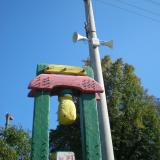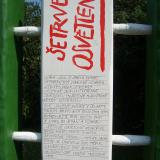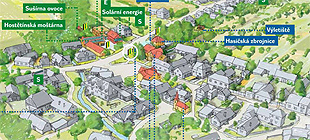
Energy Saving Public Lighting
Model public lighting in Hostětín
The street lighting fixtures were replaced and added to in Hostětín in the spring of 2006 with the goal to improve the quality of the lighting and to save energy. The reconstruction is used for the monitoring of real effects and savings in local conditions and for the education of public administration, commercial subjects and other target groups on the topic of high-quality lighting.
Until the spring of 2006, the street lighting in Hostětín had not served its purpose well. It had not been sufficiently illuminating the necessary surfaces (streets and village square) but had been lighting gardens, windows, people´s eyes, surrounding hillsides and into the air far from the village all the more. The uniformity of illumination of the streets had not been good, some places had been getting more light than necessary, other places too little. A part of the light had a quite unsuitable colour, particularly the open mercury discharge lamps lighting in all directions.
Hostětín had invested into other projects in the past and ran out of financial means needed for the reconstruction of the public lighting. Fortunately, Philips Lighting company came with a generous offer in 2005 and donated a set of top lighting fixtures and the most modern discharge lamps to the village. Ing. Jakub Wittlich, a Philips expert, elaborated a project of a new lighting. Local electrician, Karel Slámečka, installed the new lighting in the spring of 2006.
Technical solution
For the project of the new lighting the village was divided into three zones by frequency of pedestrians and speed of cars driving through:
1. Main streets with the highest frequency of people and the highest speed of cars – where the most light is needed.
2. Streets where some residents drive through occasionally - medium degree of lighting.
3. Streets used by pedestrians only - very few lights are needed.
Degrees of illumination IV, V and VI according to Czech standards were chosen for those zones.
The existing 32 light fixtures were replaced for modern, more economical and light-directing types. In order to improve the uniformity ratio of illumination, another 8 lights were added along the main street, one of them on a newly installed pole.
The light fixtures mostly contain „standard" sodium discharge lamps of power input 50 W (Master SON-T PIA Plus), which emit yellow light.
The exceptionality of the installation consists in the fact that the light fixtures were installed strictly horizontally with the use of a level.
For the village square, Philips lighting company chose extremely efficient discharge lamps 60 W CosmoPolis with electronic ballast, only available on the market since 2005. To be specific, the version of the discharge lamps was CosmoWhite so that the light was whiter and with a high-quality colour rendering. The efficiency of these sources including the ballast is over one hundred lumens per watt. Furthermore, the sources have an extremely low content of mercury - only one milligram in each discharge lamp.
Comparison of old and new look of the village
The old lighting was very non-uniform. Two lamps of four in the picture were out of order. The closest functioning lamp was old, with open mercury discharge lamp weakly illuminating the ground but all the more lighting into the eyes. Much more distant light was emitted by sodium discharge lamp and, as you may judge by the picture, it was glaring.
The street illumination after the reconstruction is more intense, more uniform and with lower power consumption. The light sources are considerably less striking with growing distance and much less glaring.
Financing
The total reconstruction investment comprises of two parts. The first one is the value of the donation from Philips Lighting company amounting to 134 thousand CZK. Further expenses were spent by the municipality on the disassembly and assembly of light fixtures and on the purchase of necessary connection accessories, and amounted to 107 000 CZK.
It is obvious that the reconstruction could have been cheaper with basic procurement. The price of such environmentally unfriendly reconstruction could have been lower than one third or one half, however, the final effect would have been significantly worse. There would have been less light in the streets than recommended by the standard and the light would have been directed to surrounding hillsides, into the windows and into the sky and thus the reconstruction would not have met the objective of eliminating the light emissions in undue directions.
Results of the Hostětín reconstruction
Harmful consequences of the public lighting were radically cut down, whilst the illumination intensity of roads and pavements increased twice or more - up to the degree recommended by the Czech standard for illumination degrees IV, V and VI. Also, light towards the surrounding hillsides and in distant air decreased ten times. At the same time, power consumption decreased by more than one third - from power input 4,6 kW of the whole lighting system to 2,9 kW. The consumption in the last years were 17 thousand kWh per year, now the municipality expects that the annual bill will be only 11 thousand kWh.
The impacts of the individual measures will be further monitored and evaluated so that the know-how might be passed on to other municipalities who face the task of reconstruction or investment in public lighting.




 Zobrazit mapu všech projektů »
Zobrazit mapu všech projektů »



